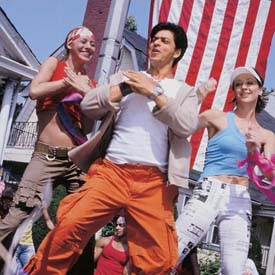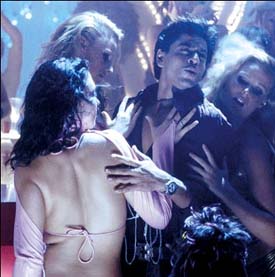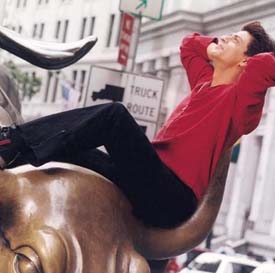
|
|
|
|
|
|
 In Kal Ho Naa Ho, one of the latest imports from
Bollywood and which translates as "Tomorrow May
Never Come", we are shown a story of love larger than
life, and the ultimate message (with Hindi subtitles) is
that the happiness of others is sometimes better than
our own selfish needs. In Kal Ho Naa Ho, one of the latest imports from
Bollywood and which translates as "Tomorrow May
Never Come", we are shown a story of love larger than
life, and the ultimate message (with Hindi subtitles) is
that the happiness of others is sometimes better than
our own selfish needs.
In the beginning of the film, we are introduced to Naina Kapur (Preity Zinta), a young immigrant from India who lives in the Southeast Asian section of Jackson Heights, Queens (we learn that by observing an envelope that she holds during the first few minutes of the film.) Naina is a girl who has lost the ability to smile due to the various troubles her family has experienced. Her father took his own life, and the family business - a small café - isn't doing well. Her home life is one of disharmony, due to constant squabbles between her mother, Jennifer (Jaya Bhaduri) and her grandmother (Jennifer's mother-in-law), who bicker about everything - the food they eat (the older lady prefers Indian food, while everyone else follows a Westernized diet), their religions (Hindu versus Catholic) and mainly the fact that Jennifer has adopted a little girl, who grandma refuses to accept as a true member of the family. Enter Aman Mathur (Shahrukh Khan, the star of the Academy Award-nominated Devdas a few years back), who notices the girl's unhappiness and does everything to bring her smile back (the Hindi version of Roy Orbison's "Pretty Woman" pretty much sets the tone for a good half of the film). He quickly befriends everyone in the family, including Naina's best friend Rohit (Saif Ali Khan, a wealthy but shy Indian Manhattanite who is attracted to his friend, but seems afraid to ruin it in the best When Harry Met Sally fashion. As Aman has Naina recover her sense of humor, he helps her mother recover their business by turning their American café into an Indian restaurant, which seems to make more sense in their neighborhood. He also tries to match Rohit and Naina, but his plan backfires when the girl falls in love with him.
 What no one knows is that Aman has a heart ailment, and
the search for a cure is what has brought him to the
USA. Without that, his days might be counted, and
he feels that he is not allowed to fall in love.
What no one knows is that Aman has a heart ailment, and
the search for a cure is what has brought him to the
USA. Without that, his days might be counted, and
he feels that he is not allowed to fall in love.
A good half of the film is played for laughs. Some of the funniest scenes are between Rohit and Aman. The two actors seem to have developed a great chemistry together, and the director has taken advantage of that. In one scene, the two men wake up together in Rohit's bed after having had too much to drink in a Manhattan nightclub. The wealthy man's house servant, an elderly Indian lady, sees them and assumes that her boss has become gay. The misunderstanding is toyed with throughout the film in a very lightweight and inoffensive way to gay people, who will - as I did - laugh out loud at the old lady's face whenever she appears. As you begin to get comfortable with the semi-comedic plot, the film turns dramatic. We learn about Naina's father's past and the reasons that led him to take his own life. The hatred between Jennifer and her mother escalates to the point that Naina has an outburst ("There is love in every family, except in this one", she screams to the women). Aman's condition worsens, but he continues on his selfless quest into making everyone around him happy. I must say that I enjoyed the film. Apart from a good story (although I did feel that the dramatic scenes were too long), the photography took advantage of the location. There are striking views of the Brooklyn Bridge, and The Manhattan skyline and other landmarks.
 The cosmopolitan blend of the film is also a plus.
After all, this is a foreign-language film, but the
plot unfolds in one of this country's melting pots, and
the director makes that clear. Not every member in the
cast is Southeast Asian, and there are "typical" New
Yorkers, Hispanics, Asians and even an extra with a
t-shirt with "Brasil" printed on it.
The cosmopolitan blend of the film is also a plus.
After all, this is a foreign-language film, but the
plot unfolds in one of this country's melting pots, and
the director makes that clear. Not every member in the
cast is Southeast Asian, and there are "typical" New
Yorkers, Hispanics, Asians and even an extra with a
t-shirt with "Brasil" printed on it.
Of course, there were a few mishaps. As a New York resident, I recognized most of the locations, but some of them didn't make sense. The excessive use of the Hoboken, N.J. train station as a main commuting waiting area didn't strike home, nor did the constant hopping between Manhattan's East Side to The Fulton Landing in Brooklyn. Naina's neighborhood doesn't look at all like Jackson Heights (and I am totally familiar with the area). The tree-lined streets and large homes look a lot like the ones on Staten Island, but then as the end credits show, some scenes were shot in Canada. The songs might seem a little too much at first (no subtitles during the musical scenes!!!), but after a while they feel right, and can be fully appreciated. Kal Ho Naa Ho is a fine Bollywood film which can be enjoyed by anyone who doesn't mind reading subtitles. It is also quite an educational experience. |
|